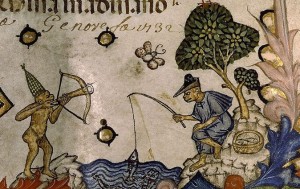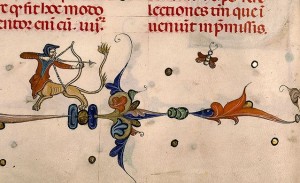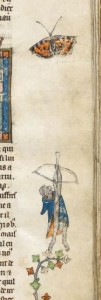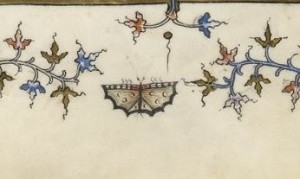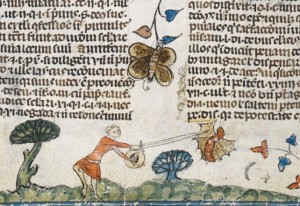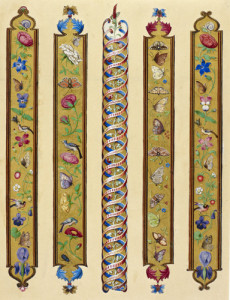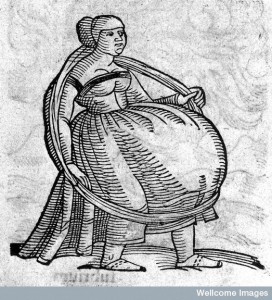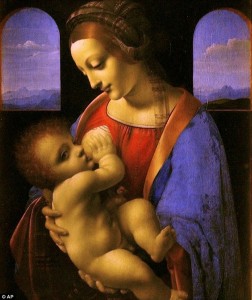In continuing my Female as Shapeshifter paper, the first part of which focused on “The true discripcion of a childe with ruffes,” I will now look at a popular seventeenth century ballad that has its roots in the thirteenth century, “The Lamenting Lady.”
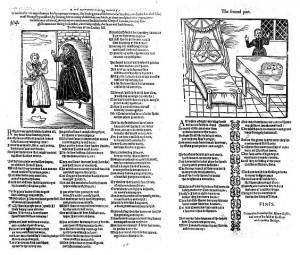
(facsimile of the ballad in Pepys 1.44-45)
I have reproduced the entirety of the ballad at the bottom, but briefly, it is told from the first person perspective of a Countess, whose identity has varied among different accounts of the tale over the centuries, and who, while refusing to help a poor beggar woman carrying twins with her, heaps myriad insults upon her, among which are allegation of infidelity, for which the Countess is cursed to give birth to 365 children at once. The Countess dies shortly after the monstrous birth, but not before instructing her audience on proper moral behavior.
This ballad operates two-fold as it overtly preaches against the sins of pride, greed, and envy, resting squarely upon the shoulders of materialism to guide the argument opposing the byproducts of relying upon earthly wealth to garner superiority above another, which can be gathered by the original categorization of this ballad in line with others on “devotion and morality.” However, it also serves as a reminder of the dangers associated with fertility.
Further, through her refusal to the beggar the Countess negates ties of reciprocal obligation which helped bind society; the Countess was too proud to ever believe her efforts would be reciprocated by a poor woman who could barely feed herself and her two babes. Of course this too relies on the notion of materialism, where the expected repayment would be equal in physical value. Mere repayment with kind words or deeds was removed from the equation, and ironically replaced with reciprocal malice. As the Countess relentlessly defames the poor woman to the point of accusations of harlotry, the beggar repays her word for word with a curse. Most interestingly, the curse is an inversion of the Countess’s crime, and her reasons behind her transgressions. Her barrenness leaves her bitter as she balks at the fertility bestowed upon a woman whom she believes to be less deserving. Despite the Countess’s numerous efforts at conceiving, including partaking in only the best foods, another woman who in all probability doesn’t even have food achieves not a single birth, but twins. Thus the Countess’s spite against the beggar’s conspicuous fertility is rewarded with excessive fertility. Pregnancy, a perceived desirable state of being, especially for the Countess, takes on the attributes of the grotesque, and transforms into a curse, or burden she must literally bear.
Fertility and the pregnant body were causes for anxiety for both practical and sociological reasons. First, for the general population, unlike the Countess of the ballad, fertility lead to pregnancy, which logically lead to another member of the family, and consequently another mouth to feed. Excessive fertility that brought about multiple children in sequence, or worse, all at once, could severally deplete the familial stores. Secondly, and for my purposes more importantly, this preoccupation with the pregnant body was tied in with the idea that childbearing had multiple extraneous influences, brought upon by the mother’s conduct or even her thoughts.
While the beggar in the ballad is asking for money or food to support herself so that her babes may continue successfully suckling, the curse placed upon the Countess is not the result of refusing to perform charity, but rather a punishment for her conduct as she doesn’t just turn the woman away, but berates her in the process. Her womb is then reconfigured in accordance to external stimuli, namely her vitriol conduct. She operates outside of socially condoned behavior, as noted by the shame she feels afterwards, and as a repercussion the sins of the mother are visited upon her unborn children. Additionally, her actions not only dictate the amount of children that are about to pour forth, but also their size. In a similar vein to the child with ruffes I looked at in my last post, here the children’s deformities are found in their size, as they are as big as newborn mice. This obviously is meant to add “credibility” to the story since the idea of 365 full sized babies would be even more physically impossible to carry, but it also plays on the anxiety of premature labor that would often result in small, and consequently weaker babies that would have a slighter chance of survival.
Much like “The true discripcion of a childe with ruffes” was created as a means of admonishing women for their immodesty during such a precarious period in their lives, this ballad also functions as a guide for women who are told to “regard” the results of the Countess’s transgressions, and heed her warnings against improper behavior. In short, it is created in response to society’s unease at the idea of female autonomy, underscoring the potential negative consequences of women being left to their own devices; women must be corralled into proper conduct for their own well-being, and to ensure the safety of their progeny.
Here is the full text of the ballad (reproduced from A Pepysian Garland, Black-Letter Broadside Ballads of the Years 1595-1639 – Chiefly from the Collection of Samuel Pepys. Ed. Hyder E. Rollins):
REgard my griefe kind Ladies all,
my heart now bleeding dyes,
And shewers of silver pearled teares
falls from my weeping eyes:
I was once lovely, faire, and young.,
by nature sweet and kinde,
And had those joyes that might content
a gallant Ladies minde.
But barren grew my wished hopes,
no children I could have,
Which twixt my wedded Lord and me
much cause of sorrows gave:
My tender body pure and faire,
and of a princely frame
Could not abstaine these surged joyes
that came by Cupid’s Game.
Yet beggers borned of low degree
such blessings did possesse,
Which when I saw my heart grew full
of woes and heaviness:
O why should people poore (quoth I)
those happy joyes obstaine
When I that am a Lady brave
should barren thus remaine?
I feed on sweet delicious meates,
and drinke the purest wine,
Yet are tehre homely bodies still
as faire and cleere as mine,
and have more sweet fac’d smiling babes
then Ladies of degree,
And of as tender flesh and blood
as can be shewed by me.
In grief of heart complaining thus,
by chance a woman poore
With two sweet children in her armes
came begging to my doore:
Poore pretty babes they smiled sweete,
whereat I needs must know
If those two smiling children were
the woman’s owne or no?
They are (sweet Madam) both (said she)
and both borne at one birth,
The which are now my chiefest wealth
and blessings on the earth:
Can Beggers have what Ladies want
in anger I repli’d,
And can they wombe be fruitfull made
when mine is still deni’d?
I goe attyr’d in garments rich
bedeck’d with burnish’d gold,
And waited on with worldly pompe,
and pleasures minfold,
Whilst thou in rags all rent and toren,
for thy relife dost crave,
And with two children blest at once,
when I not one can have.
Thou art some Stumpt sure I know,
and spend’st they dayes in shame,
And stained sure thy marriage bed
with spots of black defame:
Else unto these two lovely babes
thou canst no mother be,
When I that live in greatest grace
no such content can see.
A hundreth such like taunting termes
I gave this woman poore
Whilst she for pitty and reliefe
stood begging at the doore:
Reviling her most spightfully
with harlots hatefull name,
Dissembling with a shamelesse face
to cover up her shame.
Her heart hereat with inward griefes
did feele such mortall paine,
And as it were before my face
did seeme to breake in twaine:
her pretty babes which at her breasts
did sweetly sucking lye
To see their mothers bitter moane
did sadly sob and crye.
Whereat, halfe kild with woe alas,
I with my wrongs (quoth she)
That these my babes may be reveng’d
proud Lady upon thee:
And as I am both true and just
unto my marriage bed
so let Gods wondrous worke be show
on thee when I am dead.
And for these children two of mine
heaven send thee such a number
At once, as dayes be in the yeare,
to make the world to wonder.
For I was true a wife have beene,
unto my husbands love:
As any Lady on the earth,
unto her Lord can prove.
Hereat relenting I began,
to mourne for this misdeed:
And houre by houre in griefe therof,
my sorrowing hard doth bleed
At last a heavie hand of heaven,
revend this womans woes:
And on my bodies pampered pride,
a fearfull Judgement shoes.
My cheekes that were so lovely red,
of natures choycest dye:
Grew blacke and ugly to behould,
to every weeping eye.
And in my wombe distempered griefes,
so vext me day and night:
I sweld so bid that I appeard,
a strange and monstrous wight.
Remebring then the womans words
she grieving did impart,
A thousand strange misdoubting feares
incompast round my heart.
And then me thought I sawe her come,
in person unto me,
With her two children in her aremes,
my sodaine shame to see.
AT which affright my bigg weld wombe
delivered forth in feare
As many children at one time
as daies were in the yeare:
In bignesse all like new bred mice,
yet each one shap’d aright,
And every male from female knowne,
by Gods great power and might.
My husband hereat grieved much,
with inward cares and woe,
And knew not in what place he should
these pretty ympes bestowe:
The strange report of this rare birth
made people much admire,
And of the truth thereof to know
the neighbours did desire.
Which caus’d my sorrowes still increase
being made my Countryes scorne,
I wish’d I had in child-bed dyed
before tjhey had been borne:
Then had this shame unto my friends
beene never seene nor knowne,
Nor I inn Countries farre and neere
a wonder thus be showne.
But marke fiare women of the world
how Heaven did pitty me,
When I made sorrowe for my sinnes,
and in extremity:
God tooke from hence my cause of shame
my children, weake and small:
The which poore creatures in one grave
were strangely buried all.
And on the grave where now they lye
a monument still stands
To shew this wondrous hap of mine
unto all Christian lands,
That such as be of high degree
may beare a meeker minde,
Least they despising of the poore
the like misfortune finde.
The Lord we see his blessings sends
to many women poore
As well as to the noble sort,
that have aboundant store:
Therefore let none desire to have
the joyes of worldly things
Except it be his sacred will
that is the King of Kings.
Sources:
Crawford, Patricia. “The construction and experience of maternity in seventeenth century England.”
Macfarlane, Alan. Marriage and Love in England: Modes of Reproduction 1300-1840.
Evans, Jennifer. Aphrodisiacs, Fertility and Medicine in Early Modern England.



